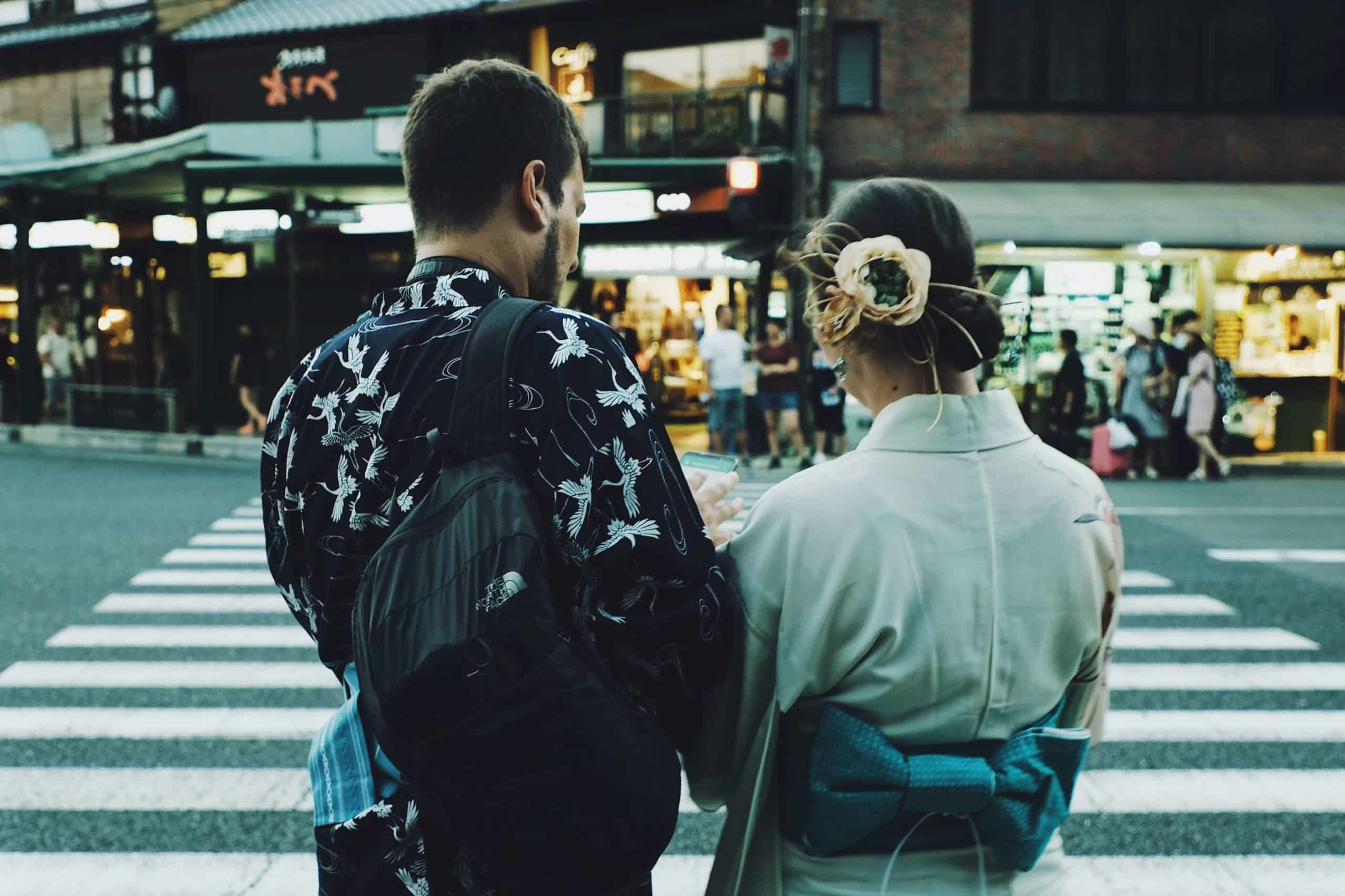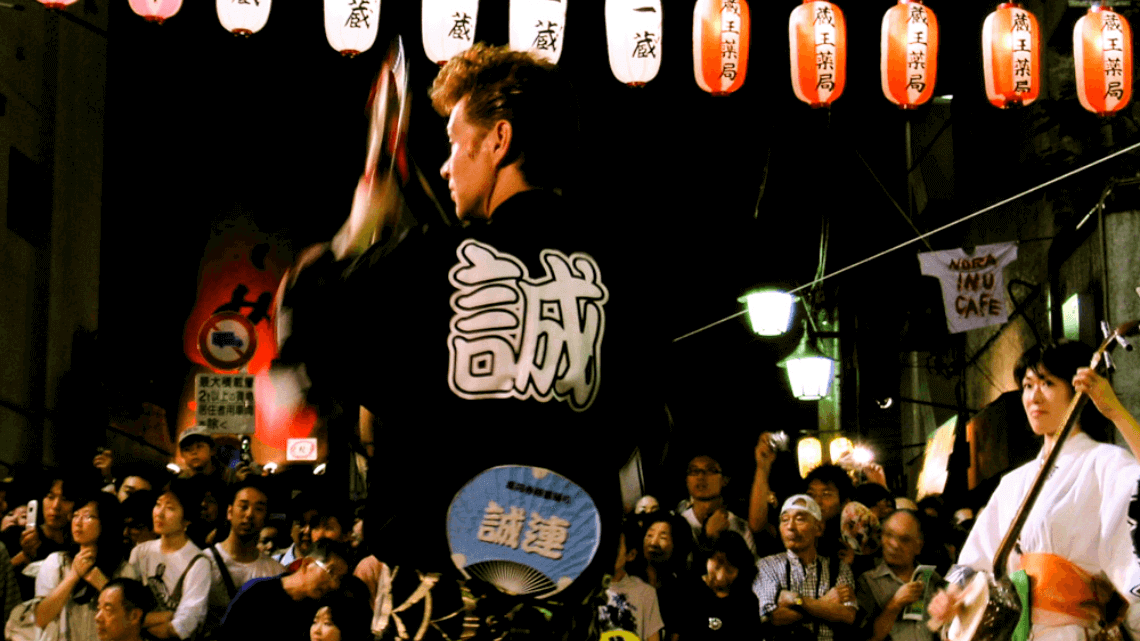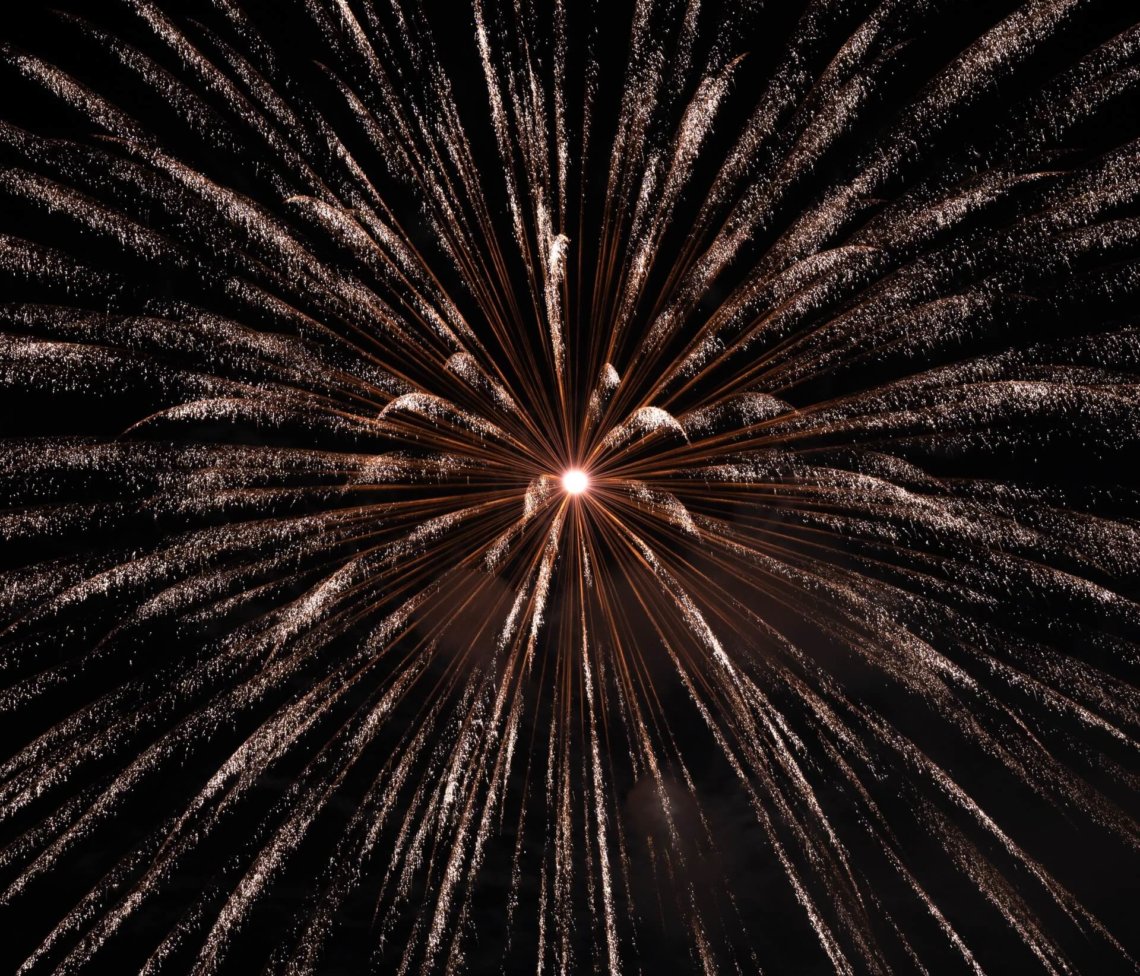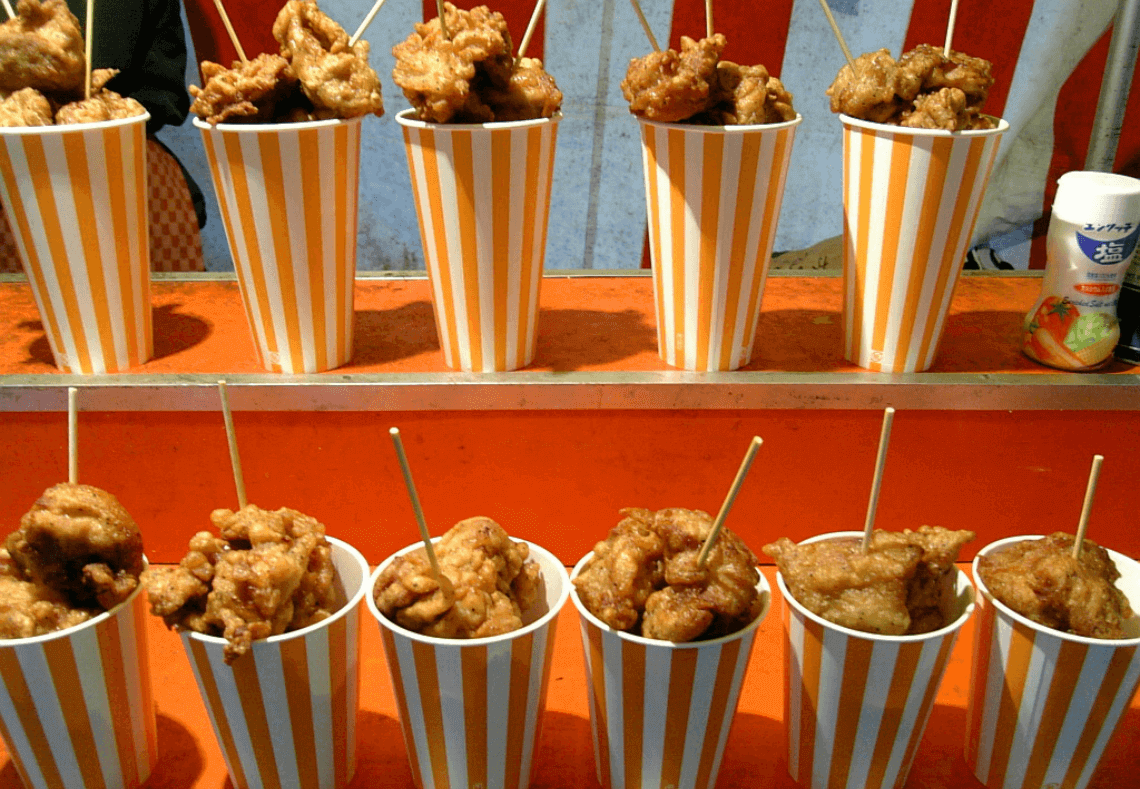Matsuri, festivals in Japan, are often spectacular, filled with color, exuberance, and tradition. Japan has perhaps more unique festivals than any other country in the world, and taking in a matsuri is an unforgettable experience.
If you want to see Japan at its liveliest, a high-energy matsuri is the place to do it! The celebrations themselves vary widely depending on the occasion, but almost always involve spirited processions of participants vigorously chanting, dancing, and bearing massive, intricately-decorated mikoshi (portable shrines) or floats.
As if all of this weren’t enough, festivals in Japan are also one of the best places to sample an incredible array of unique, casual, and seasonal Japanese foods. To the surprise of many, street food is not very prevalent in Japan (unlike in many other parts of Asia). But at matsuri you’ll find the streets lined with yatai (food stall) after colorful yatai, offering a remarkable selection of healthy (and not-so-healthy) festival snacks.
This article was last updated on December 3, 2024

The Best Japanese Festivals: Our Favorite Matsuri
Japan has too many fantastic matsuri to include in one list, and some of the most delightful are unsung festivals held in small neighborhoods throughout Japan. In our guide to Japan’s festivals below, we provide an introduction to what we consider some of the best and most interesting Japanese festivals, including:
- Kyoto’s Gion Matsuri
- Osaka’s Tenjin Matsuri
- Aomori’s Nebuta Matsuri
- The Awa Odori festival in Tokushima
- And many more!
To help you find what you’re looking for, here is a quick table of contents for easy navigation:
- List of Japanese Matsuri (Festivals)
- Tokyo’s Best Festivals: Matsuri in Tokyo
- Kyoto’s Best Festivals: Matsuri in Kyoto
- Japan’s Best Matsuri Beyond Tokyo and Kyoto
- Hanabi (Fireworks) Matsuri
- Honorable Mentions: Other Great Festivals in Japan
- More Japanese Matsuri Resources
List of Japanese Matsuri (Festivals)
If you’re in the trip-planning process and curious whether your travel dates overlap with any great festivals, here is a list of notable matsuri taking place throughout Japan (we update this list frequently).
Festivals take place year-round, with a number of the most prominent in summer. Japan’s summer is hot and muggy (read more about the seasons and weather in Japan), and the sultry weather lends itself well to the rambunctious atmosphere at many matsuri.
Festivals (Matsuri) in Japan in 2025
- February 4-11: Sapporo Yuki Matsuri Snow Festival (Sapporo)
- April 14-15: Takayama Spring Festival (Takayama)
- May 15: Aoi Matsuri (Kyoto)
- May 15: Kanda Matsuri (Tokyo)
- May 17-19: Sanja Matsuri (Tokyo)
- Month of July: Gion Matsuri (Kyoto)
- July 24-25: Tenjin Matsuri (Osaka)
- July 26: Katsushika Noryo Fireworks Festival (Tokyo)
- July 26: Sumidagawa Fireworks Festival (Tokyo)
- August 2-7: Nebuta Matsuri (Aomori)
- August 2: Edogawa Fireworks Festival (Tokyo)
- August 2: Naniwa Yodogawa Fireworks Festival (Osaka)
- August 12-15: Awa Odori (Shikoku)
- August 13-15: Hokkai Bon Odori (Sapporo) (15th day of the 7th lunar month; lasts for three days)
- August 16: Kyoto Gozan Okuribi, aka Daimonji Festival (Kyoto)
- October 9-10: Takayama Fall Festival (Takayama)
- October 22: Kurama Fire Festival (Kyoto)
- October 22: Jidai Matsuri (Kyoto)
- November 12 & 24: Asakusa Torinoichi Fair (Tokyo) (Held on Days of the Rooster in November; Days of the Rooster occur every 12 days throughout the month)
- December 2-3: Chichibu Yomatsuri (Saitama)

Tokyo’s Best Festivals: Matsuri in Tokyo
We begin with a selection of Tokyo’s best festivals.
Kanda Matsuri (Kanda Myojin Shrine, Tokyo)
Kanda was a key central district of Edo (and remains so in present-day Tokyo), and Kanda Matsuri is known as one of Tokyo’s big three festivals.
It takes place only in odd-numbered years (alternating with the Sanno Matsuri) and technically lasts an entire week, although the main parade occurs on the Saturday closest to May 15th, when over 300 people — bearing 100 mikoshi — march through the streets of central Tokyo.
This shinto festival began as a celebration of Tokugawa Ieyasu’s victory at the battle of Sekigahara, and continued as a show of wealth for the new Edo period shogunate.
Over time, the festival has come to represent prosperity for the residents, and it’s quite a spectacle to observe as the parade of portable shrines, musicians, priests on horseback, and dancers make their way through the streets, blessing local onlookers. The procession ends at Kanda Myojin Shrine.

Sanja Matsuri (Asakusa Shrine, Tokyo)
Sanja Matsuri is another boisterous shinto festival, held on the third Sunday of May (and preceding Friday and Saturday) in Tokyo’s old-fashioned Asakusa district.
The Sanja Matsuri – which draws around 2 million visitors over three days, and is considered the largest shinto festival in Tokyo – honors the three founders of Senso-ji Temple, who are enshrined in the Asakusa Shrine next door to the temple.
As the story goes, the three founders dedicated their lives to Buddhism after catching a small statue of the Boddhisatva Kannon in Tokyo’s Sumida River while fishing one morning, back in the 7th century. While the festival has possibly been around in some form since around that time, the shrine itself has only been around since 1649.
There are plenty of games and food to be enjoyed, and the festival itself is known for being relatively raucous. The streets are flooded with flute players, taiko drummers, and people chanting. On Sunday, at the height of the festival, three mikoshi — each with the spirit (kami) of one of the founders — are energetically carried through the streets before being laid back in their place of rest at Asakusa Shrine. It is said that the louder the chanting and music, and the more roughly the mikoshi are shaken, the more good luck will be bestowed upon the neighborhoods they pass.

Kyoto’s Best Festivals: Matsuri in Kyoto
Below is a small sampling of our favorite festivals in Kyoto.
Aoi Matsuri (Kamigamo Shrine, Kyoto)
Also referred to as the Kamo Matsuri, the Aoi Matsuri is an ornate, elegant festival with a procession from the Kyoto Imperial Palace to the Kamo Shrine in the north of the city. Participants dress in the elaborate style of the the Heian period (794-1185), with some on horseback and in ox-drawn carriages, and others on foot while playing Heian court music.
The origins of the Aoi Matsuri actually predate the Heian period, and it may have begun in some form as early as the 6th century, when Emperor Kinmei would deliver offerings to the Kamo Shrine in the hopes of warding off natural disaster. Eventually, this evolved into an elaborate procession during the height of the Heian period. The festival’s name comes from the hollyhock (aoi) that adorns the costumes and carriages of the participants, once considered good luck charm against natural disasters.
The Aoi Matsuri’s procession begins at the Imperial Palace at 10:30 am, and finally arrives at Kamigamo Shrine at around 3:30 pm. In addition to the parade, there are also equestrian races and events in the preceding days.

Gion Matsuri (Yasaka Shrine, Kyoto)
Gion Matsuri is perhaps Japan’s best-known festival, and possibly the largest as well. It has a long history (dating back to the year 869) and lasts the entire month of July, culminating in a parade of floats — the Yamaboko Junko — on July 17th.
Although there are festival-related events throughout the month, the main festivities occur on the day of the Yamaboko Junko (July 17th) and on the three evenings before (known as the yoiyama evenings).
“Yamaboko” refers to the two types of floats: the smaller yama floats and the massive hoko floats. Hoko floats can be up to several stories (around 25 meters) in height, and can weigh as much as 12 tons carrying festival participants. The festival floats are elaborately decorated with gorgeous tapestries and paper lanterns, and hoko floats require around 40 people to pull them through the streets.
During the yoiyama evenings, streets are closed and packed with people enjoying yatai (food stalls), performances, traditional music and costumes, and possibly even spotting geiko and maiko. This is a chance to enjoy the impressive festival floats up close, and a special opportunity to see Kyoto residents let loose!
Another fascinating aspect of the yoiyama evenings is the concurrently-held Byobu Matsuri (“Folding Screen Festival”), during which many Kyoto families open the entryways of their homes to the public, offering a glimpse of precious family heirlooms.
There is also a slightly smaller parade (with fewer floats) that takes place on July 24th, and it too is preceded by its own yoiyama nights of revelry.
Japan’s Best Matsuri Beyond Tokyo and Kyoto
Attempting to narrow all of Japan’s festivals down to a list of the best is a fool’s errand, but here is a small sampling of our favorites.
Nebuta Matsuri (Aomori Prefecture)
Nebuta Matsuri, held in the northern prefecture of Aomori, is one of Japan’s most visually striking festivals. During the Nebuta Matsuri, the streets of Aomori City come alive with breathtakingly vibrant lantern floats, which can take up to a year to build.
The magnificent floats — depicting imposing gods, warriors, kabuki actors, animals, and even TV celebrities — are made with washi (Japanese paper) and lit from the inside. Accompanying the floats are groups of dancers, taiko drummers, flutists, and other musicians.
All festival-goers are invited to join in the lively procession of dancers, provided they wear the traditional haneto dancer’s costume (readily available throughout the city).
Unlike most festivals, the Nebuta Matsuri features parades on every evening of the festival week, with the exception of the final day, when the parade is held in the afternoon.

Sapporo Yuki Matsuri (Snow Festival, Sapporo, Hokkaido)
As featured in our article on the top reasons to visit Japan in winter, every February the city of Sapporo — Hokkaido’s largest city — plays host to Sapporo Yuki Matsuri, one of the world’s great snow and ice festivals.
Renowned for its awe-inspiring ice and snow sculptures, the Sapporo Snow Festival (which dates back to 1950) attracts more than two million visitors a year. The painstaking effort and creativity that goes into each of the sculptures can be enjoyed by day, and they are even more magical in the evenings when they are beautifully illuminated.
Apart from the snow architecture, the Yuki Matsuri features a variety of events for young and old, including concerts, an international snow-sculpting competition, culinary happenings, snowball fights, snow slides, ice bars and much more.
Takayama Matsuri (Takayama, Gifu Prefecture)
Takayama’s Spring and Autumn Matsuri are among the most beautiful festivals in Japan, in great part thanks to their venue: the lovely and historic town of Takamaya in the Japan Alps.
Takayama is renowned throughout Japan for its highly-skilled craftspeople, and their handiwork is on stunning display in the spectacular festival yatai (apart from referring to food stalls, the word yatai can also refer to parade floats as it does here). The yatai are constructed with intricately carved wood, lacquer art, detailed metal work, woven textiles, and fully moving giant marionettes (karakuri ningyo).
The wheeled floats are masterpieces, but the real treat is watching the daily performances of the puppets, moved by dozens of strings and pushrods, operated from inside the float by a master puppeteer.
Takayama’s Spring festival (Haru no Takayama Matsuri) is held to pray for a great harvest after planting season, and takes place in southern Takayama at Hie Shrine (also known as Sanno Shrine). The Autumn Festival (Aki no Takayama Matsuri) gives thanks for the crops that have been harvested, and takes place in northern Takayama around the Hachiman Shrine.
Both festivals are equally worthwhile, showcasing the inimitable yatai, along with a magical evening procession (yomatsuri) on the first evening of each festival. When dusk falls, the floats — led by costumed dancers and musicians — are lit with hundreds of lanterns and pulled through the streets of Takayama, traversing the town’s picturesque bridges.
Tenjin Matsuri (Tenmangu Shrine, Osaka)
Tenjin Matsuri (“Festival of the Gods”) is an exuberant celebration that takes place at the end of July in the lively city of Osaka.
The festival celebrates Sugawara no Michizane, a poet and scholar from the Heian period who is deified at Osaka’s Tenmangu Shrine. During the procession, this patron god of art and education is paraded in his mikoshi alongside participants who include lion and umbrella dancers, musicians, goblins on horseback, and many more.
People from Osaka are known for being fun and outgoing, and while Tenjin Matsuri is a storied traditional festival with over 1,000 years of history, the atmosphere during the festival is pure fun, with endless food stalls and festive partying in the streets.
The festival peaks on its second day, when 3,000 people — outfitted in Heian period attire — proceed through the streets, then board torch-lit boats that continue along Osaka’s Okawa River. The evening culminates with a dazzling fireworks display over the flaming boats floating on the river.

Awa Odori (Tokushima, Shikoku)
The Awa Odori (Awa Dance) festival originated in rural Tokushima (formerly known as Awa Province), on the island of Shikoku.
Story has it that it dates back to the late 16th century when the feudal lord of Awa held a giant celebration at the opening of Tokushima castle. After drinking throughout the night, the attendees are said to have begun drunken singing and dancing, while musicians played a simple, syncopated beat. This became a lively annual event, and one of Japan’s most fun-loving matsuri.
Despite its somewhat remote location (we feature Shikoku in this post about great off-the-beaten-path destinations), Awa Odori draws over a million visitors to Shikoku each year.
The festival features fantastic traditional costumes, a dynamic (if stylized) dance, and highly energetic singing, chanting, and instrumentation. More than anything, it’s at its core a very friendly and colorful dance competition.
The procession is comprised of teams of dancers. Each team has its own unique costumes and spin on the traditional dance. The atmosphere is party-like, and the dance is known as the “fool’s dance.” The lyrics say it all: “The dancers are fools, and the people watching are fools. Since everyone is a fool, why not dance!”
For those who can’t make it all the way to Tokushima, it’s worth trying to catch the Tokyo version of Awa Odori, which has been held in Tokyo’s Koenji neighborhood since the 1950s.
While smaller than the original incarnation in Shikoku, even Tokyo’s version of Awa Odori has grown to attract over a million visitors each year. The Koenji neighborhood where it is held is a laid-back area just west of Shinjuku, known for its great food and drink, music venues, and vintage shops.
Chichibu Yomatsuri (Chichibu Shrine, Saitama Prefecture)
Held about 90 minutes from Tokyo, the Chichibu Yomatsuri is one of Japan’s most impressive float festivals, featuring human-powered floats that can weigh up to 20 tons. In fact, the intricately-carved floats are so large that they double as kabuki stages during the day.
A yomatsuri (night festival), the Chichibu Yomatsuri is famous for the brilliant display of lanterns covering the floats, which are accompanied by taiko drummers, flute players, and mikoshi from the 2,000-year-old Chichibu Shrine.
At the festival’s climax, the floats are pulled to the top of a slope, and the night concludes with a two-hour fireworks display – a rare treat in winter.

Hanabi (Fireworks) Matsuri
If you’re braving the heat and visiting Japan in summer, you may have the chance to attend one of the country’s dazzling hanabi (fireworks) matsuri. As anyone who has spent much time in Japan knows, fireworks are elevated to an art here, and hanabi artisans take their jobs seriously!
Throughout the summer hanabi festivals take place all over the country, and range from major events in cities like Tokyo and Osaka to regional and local displays in smaller communities. Like other matsuri, these festive celebrations are a great opportunity to relax, spend time with friends and family, and indulge in cold drinks and festival food.
Here is a short list of some of Japan’s most notable hanabi matsuri. Especially if you’re planning to attend a popular fireworks event, make extra sure to arrive early to secure a good spot!
Sumidagawa Fireworks Festival
Tokyo’s biggest hanabi event (usually attended by over one million people), with two different programs and venues, both along the Sumidagawa (Sumida River).
Edogawa Fireworks Festival
Another of Tokyo’s largest fireworks shows, held on the Edogawa (Edo River). The festival itself is around Senso-ji Temple in Tokyo’s Asakusa neighborhood.
Katsushika Noryo Fireworks Festival
Smaller in scale than Tokyo’s larger hanabi festivals, this matsuri is a good option if you want to ensure a good view. En route to the fireworks viewing area, walk through the old-fashioned streets leading to Shibamata Taishakuten Temple.
Naniwa Yodogawa Fireworks Festival
One of Osaka’s most iconic summer events, this festival is organized and run entirely by volunteers. The hanabi display is best known for showcasing its special, hand-made fireworks.

Honorable Mentions: Other Great Festivals in Japan
We couldn’t resist including a few honorable mentions, but there are countless more, as well!
Omizutori (Todaiji Temple, Nara)
During the beautiful Omizutori, every evening after sunset, priests carrying burning torches climb up to the balcony of Todaiji Temple’s Nigatsudo Hall. In addition to the beauty of the spectacle, and lovely views over Nara from Nigatsudo, the falling embers are said to grant the attendees below a safe year ahead.
Kanamara Matsuri (Kanamaya Shrine, Kawasaki)
The infamous Kanamara Matsuri (“Festival of the Steel Phallus,” most commonly known by its more colloquial name) is held in the city of Kawasaki, immediately south of Tokyo. Befitting its theme, you will find “unusual” mikoshi, candy, and trinkets, all modeled after symbols of fertility. The festival is a light-hearted and lively affair, and charitably donates proceeds to AIDS/HIV research.
Kanto Matsuri (Akita Prefecture)
As part of the Kanto Matsuri (“Pole Lantern Festival”), performers balance giant bamboo poles strung with lanterns, while drummers and other musicians play alongside. The festival’s highlights are the night parades, when the lanterns are lit with candles, and the incredible balancing acts illuminate the night.
Nagasaki Kunchi (Suwa Shrine, Nagasaki
Nagasaki Kunchi celebrates the Dutch and Chinese influences on the historic and cosmopolitan city of Nagasaki. Various neighborhood districts take part, with performances representing the cultural influences on this Japanese melting pot, including Chinese lion dances large ship-shaped floats. Though the main performances have paid seating, there are some free-seating events held throughout the city.
Jidai Matsuri (Heian Shrine, Kyoto)
Kyoto’s Jidai Matsuri (“Festival of the Ages”) takes you back in time through Kyoto’s thousand-year-reign as the capital of Japan. Over 2,000 samurai warriors, Heian court princesses, geisha, and other historically significant characters form a procession from the Imperial Palace to Heian Shrine in this photogenic reenactment of Kyoto’s storied history.
More Japanese Matsuri Resources
Hopefully you’re now excited to visit Japan and attend a dynamic matsuri or two!
Please keep in mind that for many of the above festivals — especially the most popular, such as the Sapporo Yuki Matsuri and the Takayama Festivals — significant advance planning is essential, as it’s not uncommon for accommodations to sell out months in advance.
For even more information on Japanese festivals, we also recommend the excellent Japan-Guide’s overview of festivals in Japan, and the useful Japan Atlas’ guide to Japanese festivals.


